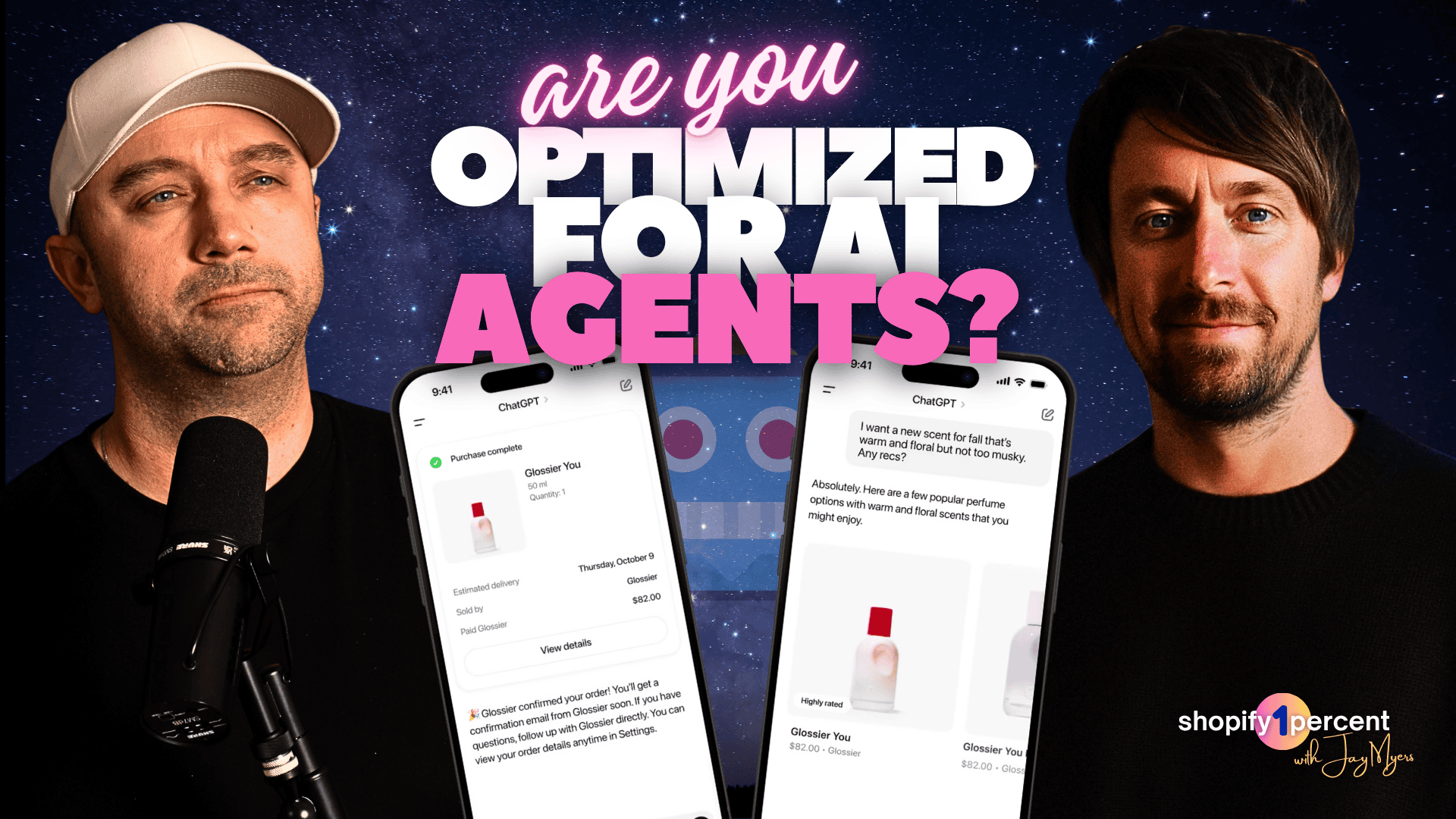How to Get Your Shopify Store Indexed in ChatGPT, Gemini, and All Other AI Searches

If you woke up thinking Shopify was still just a storefront, you missed the memo. ChatGPT now lets shoppers find a product and buy it right inside the chat. OpenAI calls it Instant Checkout, built on the new Agentic Commerce Protocol with Stripe. Single item purchases work now, multi item carts are on the roadmap. Translation for Shopify merchants: your PDPs are about to be read by robots and humans at the same time, and the robots have opinions.
I sat down with Gavin McKew, Director of Shopify Practice at Shero Commerce. He’s an operator’s operator who has shipped complex builds, migrations, and performance work. He’s also loud about making catalogs “agent ready,” which is exactly what we unpacked.
What “Agent Ready” Really Means for a Shopify Store
Short version: structure > vibe. Agents reward clarity, not adjectives. Consumers are already moving this way. Multiple studies put AI usage for shopping research near or above the 50 percent mark. If your catalog is messy, you simply do not show up.
Your 7-point readiness checklist:
-
Normalize product titles and variants
Use a consistent pattern: Brand + Core Attribute + Key Spec + Use Case. Standardize variant names and fill GTINs on every variant to reduce ambiguity for LLMs.
Why it matters: cleaner entity resolution improves match quality in agent results. -
Fill 6 high-signal metafields
use_cases,compatibility,materials,care_instructions,ships_by_days,return_window_days. Keep values short and machine readable. -
Make shipping and returns explicit
Place a numeric ship window and a clean return window high on the PDP. Agents parse numbers better than poetry. -
Add outcome language near the top
A small “Best for” block with 2 to 3 real-life scenarios. People and agents prompt with outcomes, not just specs. -
Elevate reviews from “love it” to “why it worked”
In your post purchase emails, ask three structured questions: problem solved, hesitation overcome, specific tips. Agents mine this. -
Publish machine readable policies
Returns, warranties, and exclusions as short, unambiguous bullets. This helps agents evaluate risk and recommend you. -
Include one unusual but decisive spec
That single tie breaker detail shoppers always ask support about. See examples below.
The Tiny Detail That Wins AI Tie Breakers
Gavin and I kept coming back to this: one unusual, high signal spec can beat five paragraphs of fluff. Examples you can ship by Friday:
-
Luggage: “Fits WestJet overhead bins at 21.5 in”
-
Cookware: “Safe on granite countertops”
-
Apparel: “Black stays true after 20 cold washes”
-
Battery banks: “Charges a MacBook Air M2 from 0 to 80 percent in 62 minutes”
Why it works: agents and shoppers ask outcome questions. If your PDP answers precisely, you win the recommendation and the click. Surveys show shoppers report better experiences and even use AI as a primary research source. Be the obvious answer.
Offers, Bundles, and VIP Logic in an AI Journey
Chat-based shopping starts simple, then compounds. Instant Checkout supports single item now, carts are next. Get ahead by making your offer logic deterministic and readable:
-
Bundles named by outcome: “First Apartment Kitchen Kit,” “Weekend Trail Running Pack.”
-
VIP pricing rules that can be evaluated quickly: percent off, item scope, and eligibility stated clearly.
-
Consistency across channels: price and availability mismatches make agents downgrade confidence.
OpenAI’s updates make this more urgent, not theoretical. U.S. users can buy in chat today.
Speed, Accuracy, and CX Still Win
AI did not cancel fundamentals. Fast pages, accurate inventory, clear ETAs, painless returns. Agents compare those signals instantly. Consumers are increasingly comfortable with conversational AI in retail flows, but they punish friction.
Quick wins this week:
-
Add “In stock. Usually ships in 24 hours. Typical delivery 2 to 4 days” on your top 20 SKUs.
-
Remove fuzzy phrases like “fast shipping.” Replace with numbers.
-
Audit stock syncs daily on best sellers.
Data Governance: Control Without Gatekeeping
ACP’s big promise is new distribution without surrendering your brand. It standardizes how agents talk to your commerce stack, while you control catalog, pricing, and fulfillment. Keep the core source of truth on Shopify, expose what helps agents recommend you, and route post purchase to capture identity and LTV.
Post purchase play: send a 5 minute email asking for warranty activation or VIP enrollment in exchange for one crisp perk. You still build owned audience even when checkout happened in chat.
A 30, 60, 90 Day Agent Readiness Plan
Days 1 to 30
-
Clean titles, variants, GTINs
-
Add the 6 metafields and populate for top 50 SKUs
-
Publish numeric shipping and returns blocks above the fold
Days 31 to 60
-
Add outcome bundles with clear SKUs
-
Rewrite review prompts to pull functional insights
-
Instrument a weekly “Agent Audit” where you query ChatGPT like a shopper and log gaps
Days 61 to 90
-
Expand metafields to long tail SKUs
-
Tighten price parity across channels
-
Launch post purchase identity capture that fires within 5 minutes
Adoption curves favor the prepared. Most consumers are already experimenting with or regularly using gen AI, and a meaningful slice use it specifically for shopping. Be there with clean signals.
About Gavin and Shero Commerce
Gavin McKew leads Shopify at Shero Commerce with a background spanning CTO roles and complex ecommerce builds. Shero is a Shopify focused agency known for migrations, performance, and growth work. If you need an adult in the room to operationalize agent readiness, this is that team.
FAQ for Shoppers and Agents
Q: Can it arrive by Friday?
A: Typically 2 to 4 day delivery. Numeric ETAs shown on every PDP.
Q: What is it best for?
A: Each PDP includes a “Best for” block with outcome scenarios.
Q: What is the return window?
A: 30 days from delivery. One click label.
Q: Does it fit X?
A: Compatibility is listed in a dedicated metafield and on the PDP.
These are examples, but you get the idea. Write them like this and both humans and LLMs can extract answers instantly.











